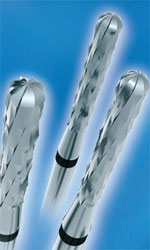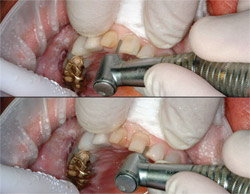Crown Prepping Carbides: Precise and Controlled Tooth Reduction
When prepping teeth for crown placement, dentists are always looking for the right rotary instrument that will provide clean margins and smooth, chatter-free cut patterns. A new instrument recently made its way to the dental market that will revolutionize the way dentist prepare teeth for crowns. The Crown Prepping Carbides (KOMET USA, Rock Hill, SC) (Figure 1) are superior to previous prepping instruments because they allow for precise and controlled tooth reduction while providing a finished surface comparable to that achieved using a diamond finisher. The Crown Prepping Carbides were introduced to the dental market during the 2007 Greater New York Dental Meeting. Their creation came as an idea presented to KOMET USA by a dentist in Florida.
Donald J. Alexander, DDS, an esthetic dentist in Jacksonville, Florida, came to KOMET USA with the idea of designing an instrument that cuts and prepares teeth faster and more safely than other instruments. Dr. Alexander assisted with the design of three instruments (H881U.314.012, H837KRU.314.014, and H837KRU.314.016). The instruments provide quick, smooth, chatter-free cut patterns. The residual finish allows for both gross and finish work to be accomplished using the same instrument. The flat-ended bur (H837KRU)—available in two sizes—is ideally designed for crown preparations that use a porcelain-butt margin. The round-ended bur (H881U) is more suited to create a chamfer for alumina or zirconia CAD/CAM copings.
Practitioners should note that Crown Prepping Carbides should not be used for crown removal. The working part is too long and the instrument is not stable enough to withstand forces caused by removing a crown. Therefore, KOMET USA recommends its special crown remover, H4MCL, which guarantees increased stability and high resistance to fracture.
Because of the Crown Prepping Carbides’ cylindrical form, the cutting depth is a known quantity, eliminating the need for depth grooves. The parallel chamfer of the H881U.314.012 bur has a cutting depth of 1.2 mm; the modified parallel shoulder H837KRU.314.014 bur has a cutting depth of 1.4 mm, and the H837KRU.314.016 bur has a cutting depth of 1.6 mm. Also, the tips were engineered to match up precisely with the required chamfer or shoulder preparation design depending on the desired material.
The round-ended bur (H881U.314.012) was used to reduce the incisal plane of the facial surface of tooth No. 8, creating a chamfer for a CAD/CAM crown. The bur was used at a depth of 1.2 mm because it is the exact width of the bur (Figure 2). Using the same bur, the dentist reduced the gingival plane of the facial surface of tooth No. 8, again using a depth of 1.2 mm (Figure 3). During this procedure, the same instrument left a residual finish while removing a good portion of the tooth structure—similar to the work of a super-coarse diamond. The same removal of tooth structure was performed on tooth No. 9 using the same bur. The tooth structure was reduced by 1.2 mm to match that of tooth No. 8—the same thickness of the bur (Figure 4 and Figure 5). According to Dr. Alexander, the prepping of both teeth took less time using this bur than other burs on the market, and left a smoother finish.
The Crown Prepping Carbides allow for a fast and precise controlled tooth reduction that results in a finished surface much better than one completed with a super-coarse diamond instrument. The finish left by these prepping instruments allows the dentist to bypass the need for an additional finishing instrument.
ACKNOWLEDGMENT
KOMET USA would like to thank Donald J. Alexander, DDS, for providing the clinical images and example for this article.
For more information, contact:
KOMET USA, LLC
Phone: 888-KOMET-USA
Web site: www.komet-usa.com
Disclaimer
The preceding material was provided by the manufacturer. The statements and opinions contained therein are solely those of the manufacturer and not of the editors, publisher, or the Editorial Board of Inside Dentistry. The preceding is not a warranty, endorsement, or approval for the aforementioned products or services or their effectiveness, quality, or safety on the part of Inside Dentistry or AEGIS Communications. The publisher disclaims responsibility for any injury to persons or property resulting from any ideas or products referred to in the preceding material.
 |  |
| Figure 1 KOMET USA’s Crown Prepping Carbides. | Figure 4 and Figure 5 Tooth reduction of the interproximal surfaces on tooth No. 9. |
 |  |
| Figure 2 Bur H881U.314.012 was used to reduce the incisal plane of the facial surface of tooth No. 8. | Figure 3 The same bur reduced the gingival plane of the facial surface of tooth No. 8. |



